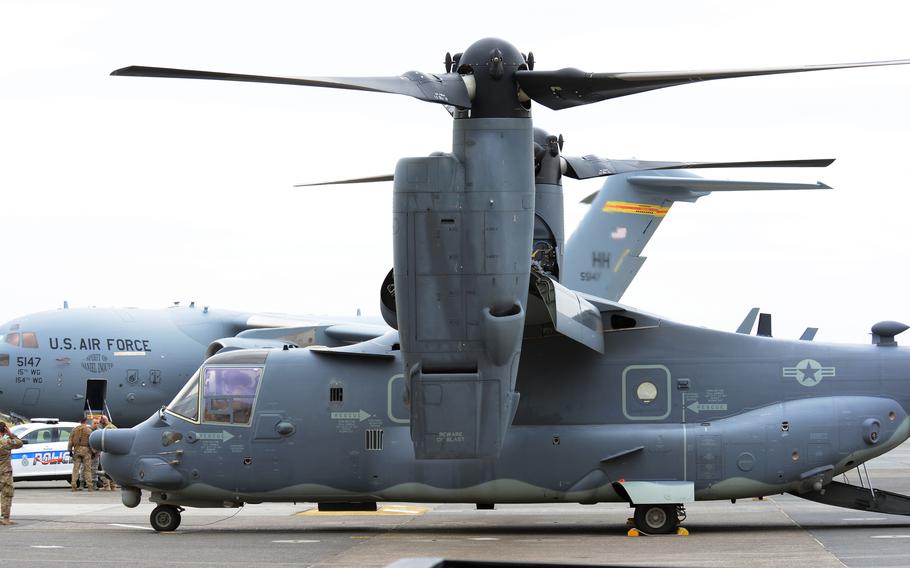Air Force
Wreckage from fatal Osprey crash returns to Marine air station in Japan
Stars and Stripes January 3, 2024

A CV-22B Osprey arrives at Yokota Air Base, Japan, April 5, 2018. (Stars and Stripes)
MARINE CORPS AIR STATION IWAKUNI, Japan — U.S. forces have recovered at least a portion of the CV-22 Osprey that crashed in November off southwestern Japan, according to Air Force and Marine Corps spokespeople.
The Air Force wreckage was delivered to Marine Corps Air Station Iwakuni, base spokesman 1st Lt. Aaron Ellis told Stars and Stripes by phone Wednesday.
The wreckage was raised Dec. 27 from the underwater crash site and arrived at the base on Saturday, according to a Sunday report by Japan Today that cited an anonymous source in the Iwakuni city government.
Lt. Col. Rebecca Heyse, a spokeswoman for Air Force Special Operations, declined Wednesday to verify that information. The command “will have additional details of what wreckage was recovered and next steps in the coming days,” she told Stars and Stripes in an email.
“The investigations — the safety investigation board and the accident investigation board — are both being led by AFSOC general officers,” Heyse wrote. “The search and recovery operations are still being led by Special Operations Command Pacific.”
The recovery comes more than a month after the tiltrotor crashed Nov. 29 off Yakushima, an island just south of Kyushu, the southernmost of Japan’s four main islands, during a routine training mission.
Since then, U.S. and Japanese crews have carried out continuous search and salvage operations to recover the Osprey and find the remains of the last of its crewmembers. Seven have been recovered and identified, but the body of Maj. Eric Spendlove, 36, of St. George, Utah, has not been found.
The remains of Staff Sgt. Jake Galliher, 24, of Pittsfield, Mass.; Maj. Luke Unrath, 34, of Riverside, Calif.; Tech Sgt. Zachary Lavoy, 33, of Oviedo, Fla.; Capt. Terrell Brayman, 32, of Pittsford, N.Y.; Staff Sgt. Jake Turnage, 25, of Kennesaw, Ga.; Senior Airman Brian Johnson, 32, of Reynoldsburg, Ohio; and Maj. Jeff Hoernemann, 32, of Andover, Minn., were recovered between Nov. 29 and Dec. 10.
The Osprey – callsign Gundam 22 – was assigned to the 353rd Special Operations Wing at Yokota Air Base in western Tokyo. It had departed MCAS Iwakuni near Hiroshima that day and was en route to Kadena Air Base on Okinawa when it crashed.
More than 1,100 people had joined in search and recovery efforts since Dec. 12. Teams had already searched the entirety of Yakushima’s 55-mile coastline and more than 31,000 square miles of the surrounding ocean surface, Air Force Special Operations Command said in a Dec. 12 news release.
At least 46 U.S. and Japanese aircraft, 11 aerial drones and 23 ships have participated in the search, while 10 underwater unmanned vessels and more than 50 divers conducted the subsurface search efforts, the command said.
Following the crash, the Air Force, Navy and Marine Corps grounded their Ospreys under a servicewide stand down until the investigation determines the cause of the crash and recommendations are made to return the aircraft to service. The Japanese military also grounded its fleet of Ospreys.